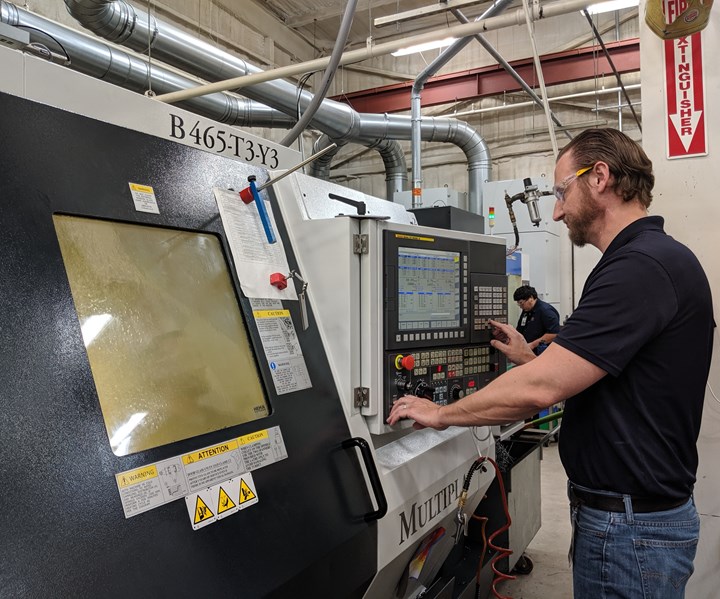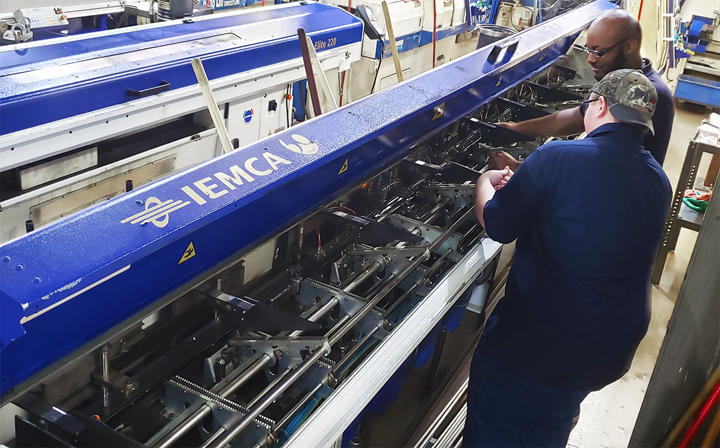As machine shops grow, they face a decision: should they add more capacity to their current capabilities or expand by adding new capabilities? San Antonio-based Cox Manufacturing chose the former, focusing on high volumes of small parts made from barstock. But the company takes this decision to standardize beyond the types of parts it makes—it extends to its equipment and its apprenticeship program. The company believes this strategy has been vital to its growth, which includes the addition of 100 employees over the past 10 years.

After using several different control models, Cox Manufacturing has standardized its 80 primary production machines with FANUC controls such as the one fixed headstock team leader, Ryan Beck, is using.
Finding a Niche
William Cox Sr. founded Cox Manufacturing in 1956 with one Swiss automatic screw machine. Today, the founder’s son, Bill Cox, leads the company. Its 170 employees work three shifts, running about 100 machines to produce more than 1 million parts each week. The parts are for a range of industries, including agriculture, medical, fiber optics, firearms, automotive, trucking and aerospace. Despite the different end uses, all parts are 2¾ inches or smaller and made from barstock. “Our niche is production automatic bar products,” Mr. Cox says.

Cox Manufacturing specializes in production automatic bar products that are 2¾ inches or smaller, such as these. It has found that standardizing both the parts it makes and the equipment it uses to make them has had a range of benefits.
The company has intentionally chosen to focus on this niche as a part of its business plan. According to Mr. Cox, when shops diversify their capabilities too much, the variety can weaken the organization’s overall strength. “We want depth to serve our customers so we can take a program and move it back and forth, or tooling and move it around,” he says. “That’s just a core strategy.”
In order to stick to its niche, the company has standardized much of its equipment. “If we buy one of anything, our intentions are to buy a second and a third,” Mr. Cox says. This applies to many areas of the shop. For example, the company is currently working to standardize its bar loaders. “Over the years, we had gotten to where we had a mix of bar loaders,” he says, “and so a major initiative this year is to replace 27 of our bar loaders to standardize.” The new bar loaders will be a mix of smaller Iemcas and larger FMBs. “The key is that the main groups are standardized,” he notes.
One of the biggest areas of equipment standardization at Cox Manufacturing is in its machine controls. “We’ve had some different controls on the production machines,” Mr. Cox explains, “but we’ve phased out everything except the FANUCs.” The company has FANUC controls on all 80 of its primary machines, which are a mix of Swiss turns and other lathes from Tornos, Deco, Tsugami and Eurotech. The controls include 32i, 31i, 18i, 16i, 16 and 18 TB, and 0i models, which range in age from less than a year old to 20 years old.
Machinists constantly interact with the control while doing their jobs, making it one of the most important features on a machine. Because of the prominent role this piece of equipment plays, the shop has seen many positive effects from standardizing with FANUC.
Apprenticeship Program

Cox Manufacturing has also established an apprenticeship program to standardize and formalize how it trains new employees. Apprentices gain shopfloor experience under the guidance of a senior machinist.
According to Mr. Cox, “One of the benefits of standardizing on one control is just standardization of training.” This is a major benefit to Cox Manufacturing because for the past 10 years, it has run a Department of Labor-approved apprenticeship program to train new employees and grow the company. Among its 170 full-time employees are 50 apprentices in various stages of the program.
The company had previously done informal training in house, but these efforts weren’t enough. “We recognized that to grow, we were going to have to grow our talent base, and we really needed to supercharge that effort,” Mr. Cox says. The company spent 18 months setting up the program, and hired a full-time training coordinator, Sean Althaus, to manage and refine it. “We’ve had a pretty healthy growth stretch over the past decade,” Mr. Cox says, “and there’s no way we could have done that without the apprenticeship program.” Mr. Althaus agrees. “When I started here there was about 70 employees, nine years ago,” he adds.
But that success has not come without ongoing challenges. First, the shop has to maintain a balance between production and training. The company relies on its experienced machinists to help train apprentices on the shop floor, and Mr. Althaus admits that it can sometimes be a struggle for them to take an extra 30 minutes to explain something to an apprentice when they’re busy. But Mr. Cox believes that it is time well spent. “If we don’t spend the time today to train, tomorrow we aren’t going to have the trained people,” he says.
Recruiting has proven to be another challenge. The selection process is competitive, so the company only hires a small proportion of the candidates who apply. Applicants are given a math test and an AcuMax personality profile to determine if they’re a good fit for the role, and the company looks for a stable work history. But with unemployment rates low, finding a sufficient pool of candidates can be difficult. To overcome this, the company has invested in recruiting efforts that include signs and billboards visible from the highway in front of its facility, as well as Craigslist ads, an employee referral program, and outreach programs to middle schools, high schools, and colleges.
Apprentices who join the program receive two types of training: related training instruction (RTI), which consists of in-person and online classes, and on-the-job learning (OJL), which is experience on the shop floor. New apprentices begin with compliance and safety training and then move on to inspection and quality control. “Before you can learn how to run the machine, you need to know if the machine’s running well or not,” Mr. Althaus explains. “If the parts are coming out good, it’s running well.” When they’ve mastered that, apprentices are sent to their permanent departments, where they learn the machines they will run.
Apprentices complete their OJL under the guidance of one of the 10 or so senior employees who serve as trainers. They first learn to run one machine, then two, then three. When they can handle production machining without being supervised, they learn to set up new jobs. When they’ve mastered that, they begin to learn machining principles and theories. “They should be able to answer why they’re doing what they’re doing and explain that to a lower-level apprentice so they can eventually grow into that,” Mr. Althaus explains. At that stage, the team leader validates the apprentices, and they sit on a review board with master machinists, who ask them questions to test their understanding of machining. “And if they can explain the why behind the what, they’re a machinist, and that’s when they graduate,” he says.

Apprentices also receive training via online classes from ToolingU. Company President Bill Cox shows some of the classes apprentices take.
To fulfill the RTI component of the program, apprentices are paid for an additional labor hour per week, during which they are expected to complete two classes from ToolingU’s online curriculum from home. These classes cover metalcutting, safety, automated machining for both CNCs and screw machines, quality, and inspection. Some are required, while others are electives apprentices choose to take for credit. To complete the program, participants must finish about 200 ToolingU classes. Graduates are also free to continue taking classes if they are interested.
The company’s commitment to standardization applies to its apprenticeship program. It is designed to be a base from which graduates can move to a range of different roles within the company. “I grew into a training coordinator HR role,” Mr. Althaus says. Others have gone on to become team leaders, engineers, go-to setup technicians and toolmakers. The role apprentices take on after graduation is dependent on both their skill set and the company’s needs, but they all require the same foundational knowledge and skills.
The shop’s standardization of controls also benefits the apprentices. “They’re interfacing with that control constantly,” Mr. Cox says. “To do their job, they’ve got to be able to use that control.” He compares using machines with different controls to switching between using a Mac and a PC—it requires an adjustment period, and having to do so frequently would be an inconvenience that could take time and result in errors. Standardizing the control helps apprentices as they learn to run more machines and enables them to move into new roles upon completion of the program.
Additional Benefits
In addition to easing training, the company has seen a range of additional benefits from standardizing with FANUC controls:
-
Program Transfers. This is a frequent occurrence at Cox Manufacturing. “It happens all the time because we have banks of machines,” Mr. Cox explains. Using the same brand of control enables machinists to seamlessly move programs from one machine to another. “If you have a mix of controls, you’d have to rewrite it to move it around,” he says. Because all of the FANUC control models are compatible, programmers only have to write a single program, and it will work on any of the machines.
According to fixed headstock team leader, Ryan Beck, the process of transferring programs between machines with FANUC controls is simple. “From a user standpoint it’s exceptionally easy, especially on the newer models with USB. If you know how to operate a home PC, you know how to transfer a program,” he says. “Even the older models, the old 18s, it’s three buttons to transfer over. I’ve used controls where program control can take up to five or six minutes. Each individual block of the program had to be done separately.”
-
IIoT Preparedness. Cox Manufacturing is at the beginning stages of Industry 4.0, and so far, it has found that having the same brand of control on its machines has helped ease the transition. “The less variety you have in your shop of controls and machines, the easier it’s going to be for you to implement the new strategy of IIoT,” Mr. Cox says. His computer analogy applies here as well. “If you can imagine an office with PCs and Macs at every other desk and you want to network them and share data, it would be a nightmare,” he notes.
-
Maintenance and service. Standardizing on FANUC controls has also benefited the service and maintenance of Cox Manufacturing’s controls. For one, the company’s maintenance technicians require less training, just like its machinists. Sticking with one company has also meant the company deals with fewer service people. Working with the same technicians from the same company is helpful for both day-to-day maintenance operations and bigger projects, such as implementing Industry 4.0. The service team knows how the company works and what its needs are. “All their technicians know all our technicians,” says maintenance technician Mike Hernandez.

The controls at Cox Manufacturing range in age from less than a year to 20 years old, and FANUC provides service for all of them. By keeping these old controls running, the company can invest money in equipment that expands its capacity.
Cox Manufacturing has so many FANUC controls that it decided to invest in a standard maintenance contract. “You have a budgeted expense to maintain your controls,” Mr. Cox explains. “It’s like an insurance policy.” One feature of this contract is access to the FANUC Portal, which stores all of the company’s service requests over the past year. Cox’s maintenance technicians can reference these service logs to correct reoccurring issues. It also contains a library with manuals for all its controls, which the company references when troubleshooting.
FANUC supports all of its controls at Cox Manufacturing, including the ones that are 20 years old. This means that instead of having to invest in new control models, the company can keep its old controls running and invest money in new machines that will help the company continue to grow.
Cox Manufacturing | 800-752-1768 | coxmanufacturing.com
Related Content
The Gen Z Effect: Transforming Manufacturing Towards the Future
Discover how Gen Z is reshaping the manufacturing workforce with their values of flexibility, sustainability, technological advancement and inclusivity.
Read MoreSkilled Manufacturers Need to Adopt a Learning Philosophy
The Dreyfus Model of Skill Acquisition can accommodate the type of workforce development needs required by today’s machine shops to foster shopfloor employee advancement.
Read MoreSwiss Happens: 8 Swiss-Type Articles to Keep Your Skills Sharp
Learn the history of Swiss-type lathes, practical ways to implement these sliding-headstock machines in your shop, and much more in this collection of articles.
Read MoreHiring A New Generation — Generation Z
Be prepared and understand what many don’t know about Gen Z.
Read MoreRead Next
Finding the Right Tools for a Turning Shop
Xcelicut is a startup shop that has grown thanks to the right machines, cutting tools, grants and other resources.
Read MoreHow To (Better) Make a Micrometer
How does an inspection equipment manufacturer organize its factory floor? Join us as we explore the continuous improvement strategies and culture shifts The L.S. Starrett Co. is implementing across the over 500,000 square feet of its Athol, Massachusetts, headquarters.
Read More





















